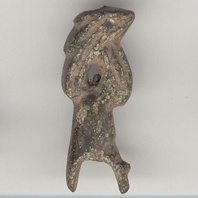
Viking Objects
Prick Spur (LIN-DC6E82)
Early spurs had a neck that ended in a point, called a prick, riveted to the heel band. This object is a fragment of the prick and is cylindrical in section. It is broken at the lowest point where it divides into two arms. There is a hollow shaft above leading into two decorative crescent-shaped arms, one arching over the other. Each arm is longitudinally ribbed. The very top of the object is also pierced, allowing something to pass vertically through the entire object.
Read More
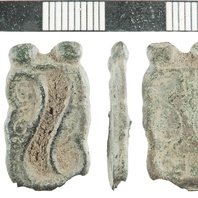
Viking Objects
Strap-End (NLM-E77782)
This copper-alloy strap-end fragment is classified as a Thomas Class B5 type and is decorated with wavy bilateral ornamentation which may show Carolingian influences. Strap-ends came in various styles and were fairly common throughout the Viking world. They were used to decorate the ends of belts and to stop them getting damaged.
Read More
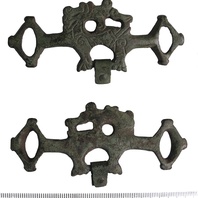
Viking Objects
Harness Fitting (LIN-7C2052)
This is either a harness fitting or strap distributor on which the central part is decorated with Ringerike-style ornament which was used for most of the eleventh century.
Read More
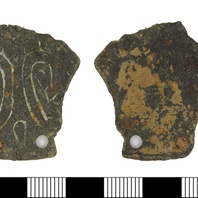
Viking Objects
Stirrup-Mount Fragment (LEIC-534DFF)
This copper-alloy stirrup-strap mount, classified as a variant of Williams Class A Type 1, is decorated with two sets of double curving incised lines that may represent beasts.
Read More
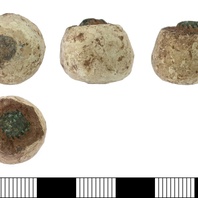
Viking Objects
Spherical Lead-Alloy Weight (DENO-650DB1)
This is a cast lead-alloy weight with a copper alloy Anglo-Saxon pin embedded in the centre. The base features a flattened copper alloy circular area that may be the worn remains of another embedded object. This piece demonstrates Anglo-Scandinavian reuse and repurposing of Anglo-Saxon metalwork. It has also been suggested that this item was a gaming piece although it does not resemble other known gaming pieces. Weights are an important form of evidence for Viking Age commerce and the use of standards across the different economic systems within which Vikings were integrated. Many of the weights discovered, particularly ones in Ireland and those of Arabic type, suggest that a standardized system of weights existed in some areas. These standard weights, alongside standard values of silver, are what allowed the bullion economy of Viking-occupied areas to function. A bullion economy was a barter economy that relied on the exchange of set amounts of precious metal in various forms, such as arm-rings or coins, for tradeable goods, such as food or textiles. Each merchant would have brought their own set of weights and scales to a transaction to make sure that the trade was conducted fairly.
Read More
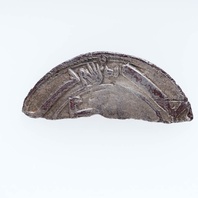
Item
Abbasid Silver Dirham Fragment (CM_1770_2008)
This fragment of a silver dirham was minted for the Abbasid ruler at Madinat al-Salam, [180-183] 796-799 CE . The dirham was a unit of weight used across North Africa, the Middle East, and Persia, with varying values which also referred to the type of coins used in the Middle East during the Viking Age. These coins were extremely prized possessions not only for their silver value but as a way of displaying one’s wealth and vast trade connections. Millions of Arabic Dirhams would have been imported throughout the Viking world and are mostly found in hoards. Arabic dirhams like this one from Torksey demonstrate contact between the Viking diaspora and the Arabic world. Arabic coins are especially useful for dating sites, because they carry the date when they were minted. This permits precise dating where the part of the coin with the date survives, whereas European coins can only be dated to the reign of the ruler depicted on them. In western descriptions of these coins, the Arabic dates found on the coins are usually listed in square brackets, as above, and the European equivalent is listed after it. This coin is a product of the Abbasid Caliphate which was ruled from its capital in Baghdad. The Abbasid Caliphate was at its greatest extent c.850 CE, occupying lands from Morocco in the west to Afghanistan in the east.
Read More
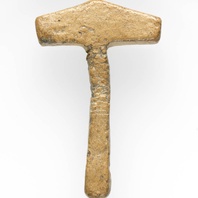
Viking Objects
Lead Thor’s Hammer Pendant (CM_569_2010)
A lead Thor’s hammer pendant with a trapezoidal head and pierced base. These may have been worn to show devotion to the god Thor, or to secure the god’s protection, although there is little evidence to support this interpretation. Pendants like this have been found made of lead, copper alloy, silver and gold, showing that many different strata of society could have worn them. For more information on Scandinavian jewellery in England check out our blog: Brooches, Pendants and Pins: Scandinavian Dress Accessories in England.
Read More
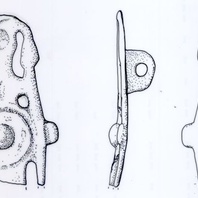
Viking Objects
Pendant (LEIC-C58A13)
This copper-alloy pendant depicts an individual holding a shield and a sword. Similar designs have been seen in pendants from southern Scandinavia which are generally identified as valkyries, though they could represent other mythological figures. The closest parallel in England is an example from Wickham Market, Suffolk. .
Read More
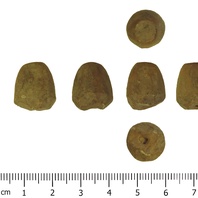
Viking Objects
Lead-Alloy Gaming Piece (DENO-7DABAC)
Lead gaming pieces like this one are a common find throughout the East Midlands, including the Torksey Viking camp. Gaming pieces would have been used to play games such as hnefatafl or Nine Men’s Morris, both of which are known to have been played by Scandinavians throughout the Viking diaspora.
Read More
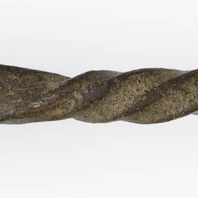
Viking Objects
Silver Ear Scoop Fragment (CM.1850-2008)
A fragment of a silver ear spoon or ear scoop with a body made from a spiral-twisted bar. Toilet articles like this were an important part of personal hygiene in the Viking Age. They were used to clean ear wax out of the ear and could be highly decorated to show off the user’s status.
Read More
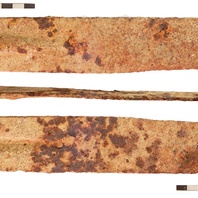
Viking Objects
Scythe (NLM-739C96)
Scythes such as this one would have been common agricultural implements. Dr Kevin Leahy comments that while the scythe has a similar shape to other early medieval examples, the lack of a typical bent tang leaves its dating in question.
